ACC341 Accounting Theory: Pioneer Credit and Exposure Draft
VerifiedAdded on 2023/03/17
|15
|2923
|56
Report
AI Summary
This report delves into accounting theory, focusing on a case study of Pioneer Credit and an analysis of an IASB exposure draft. The report begins with an executive summary, followed by an introduction that outlines the current accounting issues related to accounting theory and the changes implied in accounting policies. The first question addresses corporate regulator discussions with Pioneer Credit. The report analyzes the company's accounting standards and the implications for the Australian community and shareholders. The second question examines the major issues covered in the exposure draft concerning interest rate benchmarks. It discusses the implications of the proposed changes, regulator behavior, and the views presented in the draft. The report applies public interest, private interest, and capture theories to the comment letters. The report concludes by critically evaluating the underlying assumptions of the applied theories and perspectives of regulation. The report references various sources, including the Australian Financial Review, IFRS Foundation, and academic literature, and includes an analysis of the application of each theory.
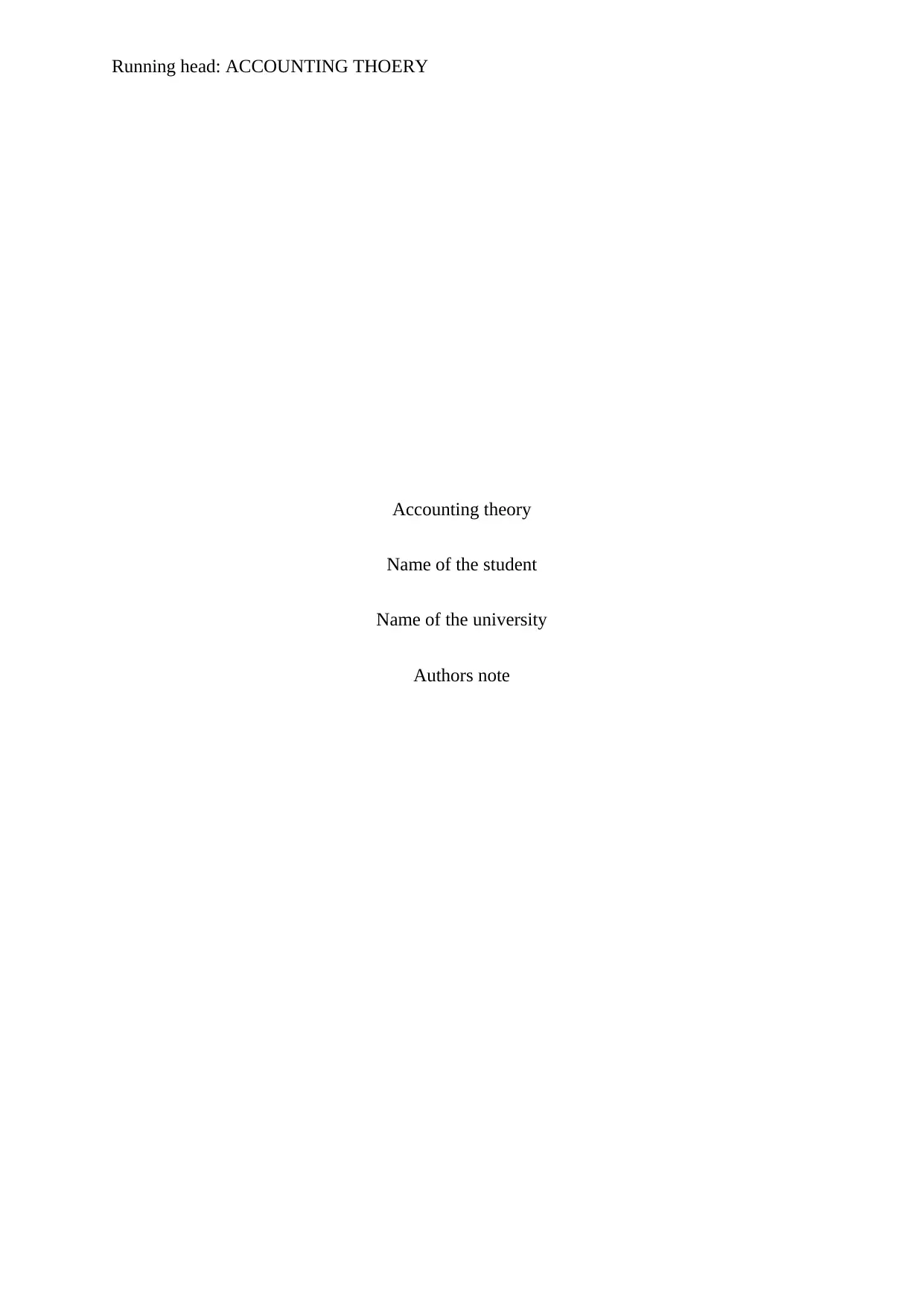
Running head: ACCOUNTING THOERY
Accounting theory
Name of the student
Name of the university
Authors note
Accounting theory
Name of the student
Name of the university
Authors note
Paraphrase This Document
Need a fresh take? Get an instant paraphrase of this document with our AI Paraphraser
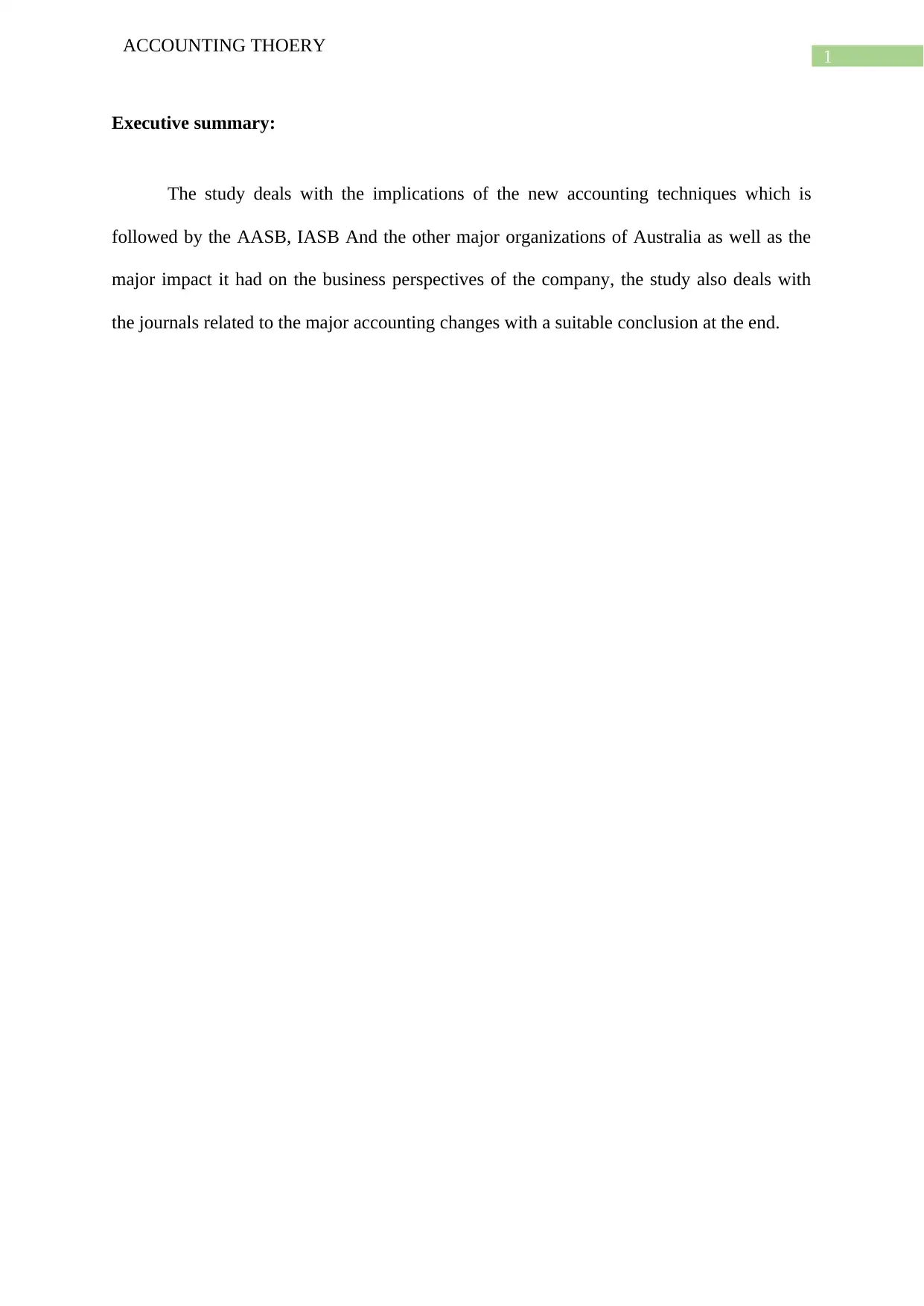
1
ACCOUNTING THOERY
Executive summary:
The study deals with the implications of the new accounting techniques which is
followed by the AASB, IASB And the other major organizations of Australia as well as the
major impact it had on the business perspectives of the company, the study also deals with
the journals related to the major accounting changes with a suitable conclusion at the end.
ACCOUNTING THOERY
Executive summary:
The study deals with the implications of the new accounting techniques which is
followed by the AASB, IASB And the other major organizations of Australia as well as the
major impact it had on the business perspectives of the company, the study also deals with
the journals related to the major accounting changes with a suitable conclusion at the end.
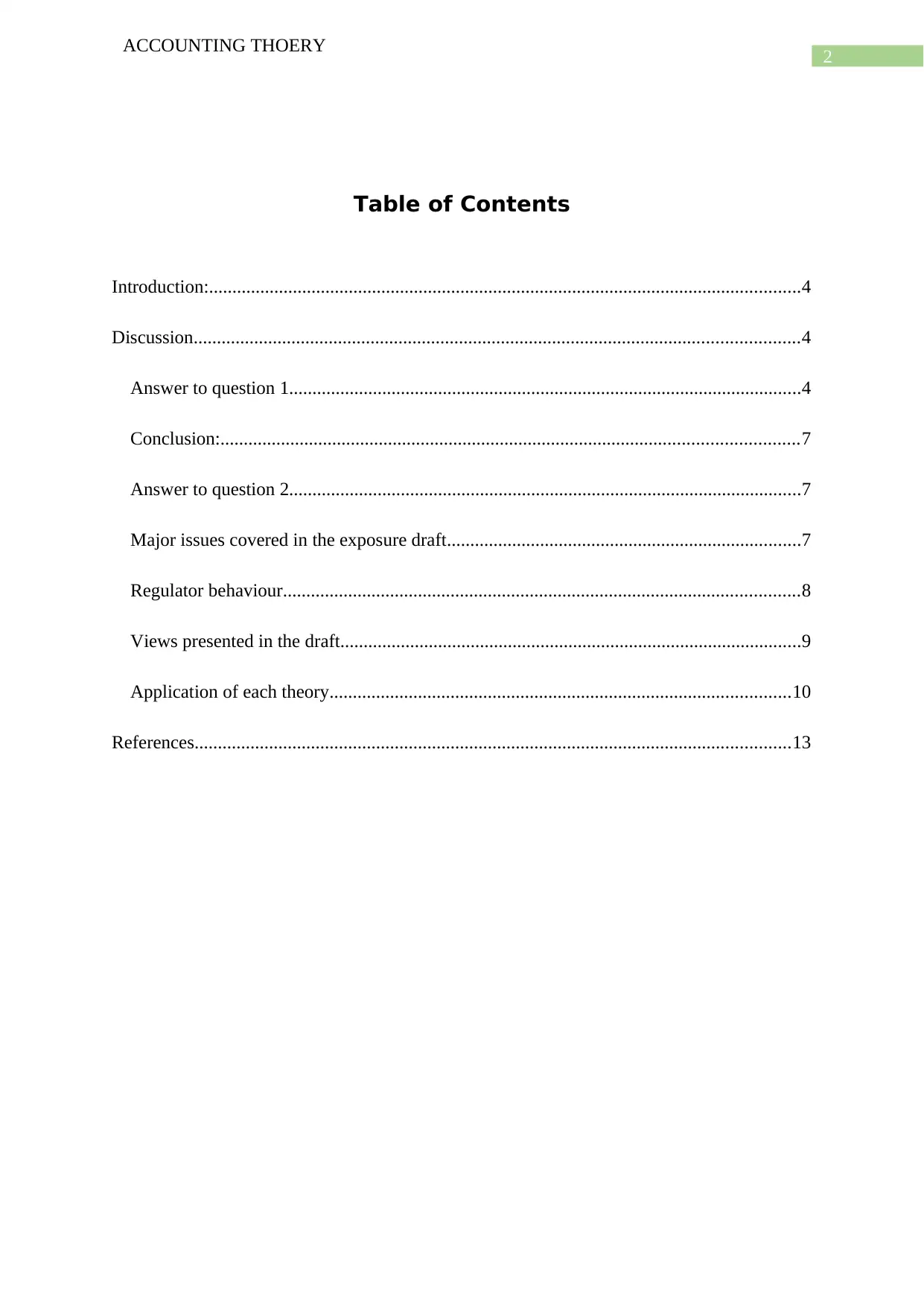
2
ACCOUNTING THOERY
Table of Contents
Introduction:...............................................................................................................................4
Discussion..................................................................................................................................4
Answer to question 1..............................................................................................................4
Conclusion:............................................................................................................................7
Answer to question 2..............................................................................................................7
Major issues covered in the exposure draft............................................................................7
Regulator behaviour...............................................................................................................8
Views presented in the draft...................................................................................................9
Application of each theory...................................................................................................10
References................................................................................................................................13
ACCOUNTING THOERY
Table of Contents
Introduction:...............................................................................................................................4
Discussion..................................................................................................................................4
Answer to question 1..............................................................................................................4
Conclusion:............................................................................................................................7
Answer to question 2..............................................................................................................7
Major issues covered in the exposure draft............................................................................7
Regulator behaviour...............................................................................................................8
Views presented in the draft...................................................................................................9
Application of each theory...................................................................................................10
References................................................................................................................................13
⊘ This is a preview!⊘
Do you want full access?
Subscribe today to unlock all pages.

Trusted by 1+ million students worldwide

3
ACCOUNTING THOERY
ACCOUNTING THOERY
Paraphrase This Document
Need a fresh take? Get an instant paraphrase of this document with our AI Paraphraser
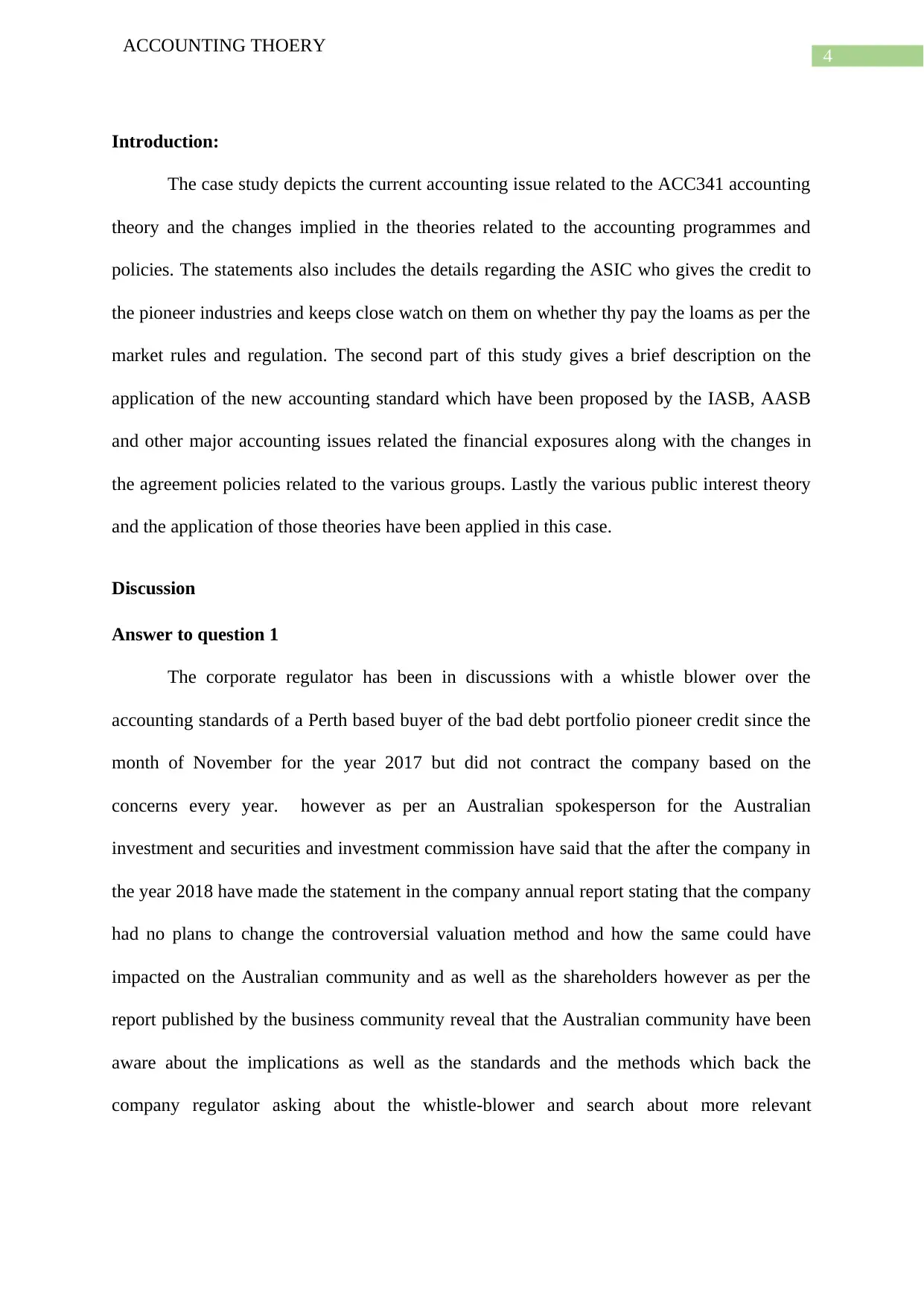
4
ACCOUNTING THOERY
Introduction:
The case study depicts the current accounting issue related to the ACC341 accounting
theory and the changes implied in the theories related to the accounting programmes and
policies. The statements also includes the details regarding the ASIC who gives the credit to
the pioneer industries and keeps close watch on them on whether thy pay the loams as per the
market rules and regulation. The second part of this study gives a brief description on the
application of the new accounting standard which have been proposed by the IASB, AASB
and other major accounting issues related the financial exposures along with the changes in
the agreement policies related to the various groups. Lastly the various public interest theory
and the application of those theories have been applied in this case.
Discussion
Answer to question 1
The corporate regulator has been in discussions with a whistle blower over the
accounting standards of a Perth based buyer of the bad debt portfolio pioneer credit since the
month of November for the year 2017 but did not contract the company based on the
concerns every year. however as per an Australian spokesperson for the Australian
investment and securities and investment commission have said that the after the company in
the year 2018 have made the statement in the company annual report stating that the company
had no plans to change the controversial valuation method and how the same could have
impacted on the Australian community and as well as the shareholders however as per the
report published by the business community reveal that the Australian community have been
aware about the implications as well as the standards and the methods which back the
company regulator asking about the whistle-blower and search about more relevant
ACCOUNTING THOERY
Introduction:
The case study depicts the current accounting issue related to the ACC341 accounting
theory and the changes implied in the theories related to the accounting programmes and
policies. The statements also includes the details regarding the ASIC who gives the credit to
the pioneer industries and keeps close watch on them on whether thy pay the loams as per the
market rules and regulation. The second part of this study gives a brief description on the
application of the new accounting standard which have been proposed by the IASB, AASB
and other major accounting issues related the financial exposures along with the changes in
the agreement policies related to the various groups. Lastly the various public interest theory
and the application of those theories have been applied in this case.
Discussion
Answer to question 1
The corporate regulator has been in discussions with a whistle blower over the
accounting standards of a Perth based buyer of the bad debt portfolio pioneer credit since the
month of November for the year 2017 but did not contract the company based on the
concerns every year. however as per an Australian spokesperson for the Australian
investment and securities and investment commission have said that the after the company in
the year 2018 have made the statement in the company annual report stating that the company
had no plans to change the controversial valuation method and how the same could have
impacted on the Australian community and as well as the shareholders however as per the
report published by the business community reveal that the Australian community have been
aware about the implications as well as the standards and the methods which back the
company regulator asking about the whistle-blower and search about more relevant
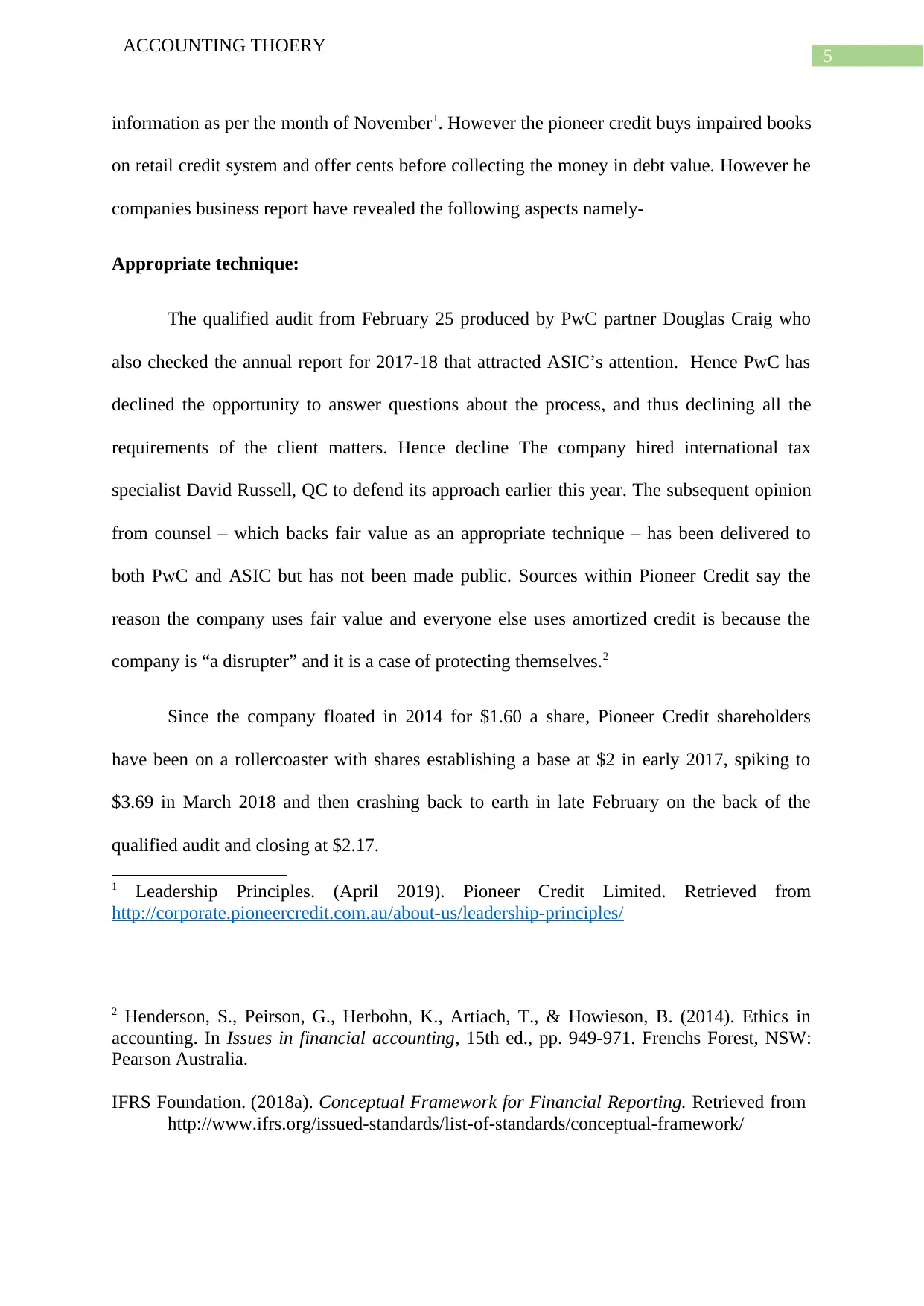
5
ACCOUNTING THOERY
information as per the month of November1. However the pioneer credit buys impaired books
on retail credit system and offer cents before collecting the money in debt value. However he
companies business report have revealed the following aspects namely-
Appropriate technique:
The qualified audit from February 25 produced by PwC partner Douglas Craig who
also checked the annual report for 2017-18 that attracted ASIC’s attention. Hence PwC has
declined the opportunity to answer questions about the process, and thus declining all the
requirements of the client matters. Hence decline The company hired international tax
specialist David Russell, QC to defend its approach earlier this year. The subsequent opinion
from counsel – which backs fair value as an appropriate technique – has been delivered to
both PwC and ASIC but has not been made public. Sources within Pioneer Credit say the
reason the company uses fair value and everyone else uses amortized credit is because the
company is “a disrupter” and it is a case of protecting themselves.2
Since the company floated in 2014 for $1.60 a share, Pioneer Credit shareholders
have been on a rollercoaster with shares establishing a base at $2 in early 2017, spiking to
$3.69 in March 2018 and then crashing back to earth in late February on the back of the
qualified audit and closing at $2.17.
1 Leadership Principles. (April 2019). Pioneer Credit Limited. Retrieved from
http://corporate.pioneercredit.com.au/about-us/leadership-principles/
2 Henderson, S., Peirson, G., Herbohn, K., Artiach, T., & Howieson, B. (2014). Ethics in
accounting. In Issues in financial accounting, 15th ed., pp. 949-971. Frenchs Forest, NSW:
Pearson Australia.
IFRS Foundation. (2018a). Conceptual Framework for Financial Reporting. Retrieved from
http://www.ifrs.org/issued-standards/list-of-standards/conceptual-framework/
ACCOUNTING THOERY
information as per the month of November1. However the pioneer credit buys impaired books
on retail credit system and offer cents before collecting the money in debt value. However he
companies business report have revealed the following aspects namely-
Appropriate technique:
The qualified audit from February 25 produced by PwC partner Douglas Craig who
also checked the annual report for 2017-18 that attracted ASIC’s attention. Hence PwC has
declined the opportunity to answer questions about the process, and thus declining all the
requirements of the client matters. Hence decline The company hired international tax
specialist David Russell, QC to defend its approach earlier this year. The subsequent opinion
from counsel – which backs fair value as an appropriate technique – has been delivered to
both PwC and ASIC but has not been made public. Sources within Pioneer Credit say the
reason the company uses fair value and everyone else uses amortized credit is because the
company is “a disrupter” and it is a case of protecting themselves.2
Since the company floated in 2014 for $1.60 a share, Pioneer Credit shareholders
have been on a rollercoaster with shares establishing a base at $2 in early 2017, spiking to
$3.69 in March 2018 and then crashing back to earth in late February on the back of the
qualified audit and closing at $2.17.
1 Leadership Principles. (April 2019). Pioneer Credit Limited. Retrieved from
http://corporate.pioneercredit.com.au/about-us/leadership-principles/
2 Henderson, S., Peirson, G., Herbohn, K., Artiach, T., & Howieson, B. (2014). Ethics in
accounting. In Issues in financial accounting, 15th ed., pp. 949-971. Frenchs Forest, NSW:
Pearson Australia.
IFRS Foundation. (2018a). Conceptual Framework for Financial Reporting. Retrieved from
http://www.ifrs.org/issued-standards/list-of-standards/conceptual-framework/
⊘ This is a preview!⊘
Do you want full access?
Subscribe today to unlock all pages.

Trusted by 1+ million students worldwide
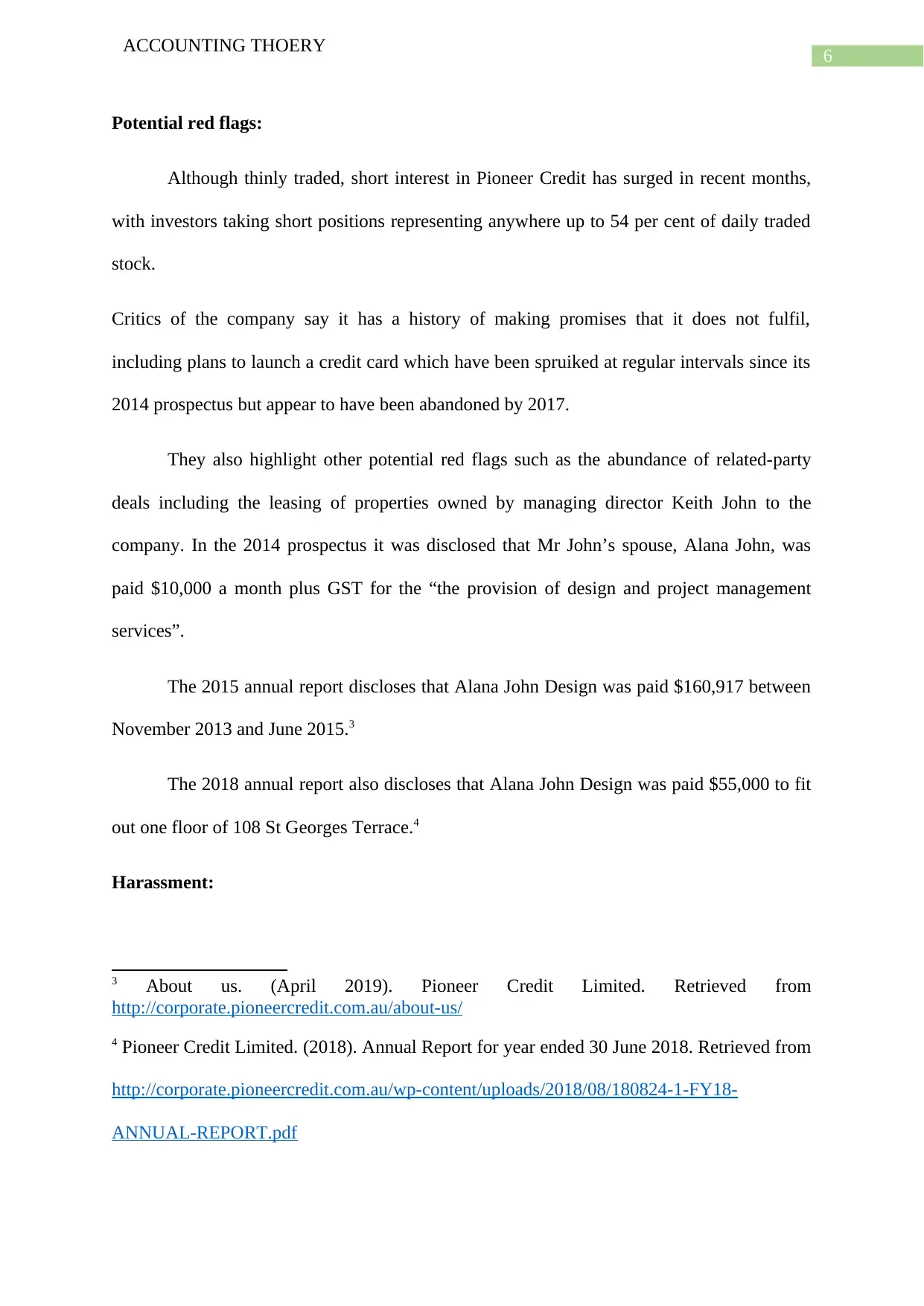
6
ACCOUNTING THOERY
Potential red flags:
Although thinly traded, short interest in Pioneer Credit has surged in recent months,
with investors taking short positions representing anywhere up to 54 per cent of daily traded
stock.
Critics of the company say it has a history of making promises that it does not fulfil,
including plans to launch a credit card which have been spruiked at regular intervals since its
2014 prospectus but appear to have been abandoned by 2017.
They also highlight other potential red flags such as the abundance of related-party
deals including the leasing of properties owned by managing director Keith John to the
company. In the 2014 prospectus it was disclosed that Mr John’s spouse, Alana John, was
paid $10,000 a month plus GST for the “the provision of design and project management
services”.
The 2015 annual report discloses that Alana John Design was paid $160,917 between
November 2013 and June 2015.3
The 2018 annual report also discloses that Alana John Design was paid $55,000 to fit
out one floor of 108 St Georges Terrace.4
Harassment:
3 About us. (April 2019). Pioneer Credit Limited. Retrieved from
http://corporate.pioneercredit.com.au/about-us/
4 Pioneer Credit Limited. (2018). Annual Report for year ended 30 June 2018. Retrieved from
http://corporate.pioneercredit.com.au/wp-content/uploads/2018/08/180824-1-FY18-
ANNUAL-REPORT.pdf
ACCOUNTING THOERY
Potential red flags:
Although thinly traded, short interest in Pioneer Credit has surged in recent months,
with investors taking short positions representing anywhere up to 54 per cent of daily traded
stock.
Critics of the company say it has a history of making promises that it does not fulfil,
including plans to launch a credit card which have been spruiked at regular intervals since its
2014 prospectus but appear to have been abandoned by 2017.
They also highlight other potential red flags such as the abundance of related-party
deals including the leasing of properties owned by managing director Keith John to the
company. In the 2014 prospectus it was disclosed that Mr John’s spouse, Alana John, was
paid $10,000 a month plus GST for the “the provision of design and project management
services”.
The 2015 annual report discloses that Alana John Design was paid $160,917 between
November 2013 and June 2015.3
The 2018 annual report also discloses that Alana John Design was paid $55,000 to fit
out one floor of 108 St Georges Terrace.4
Harassment:
3 About us. (April 2019). Pioneer Credit Limited. Retrieved from
http://corporate.pioneercredit.com.au/about-us/
4 Pioneer Credit Limited. (2018). Annual Report for year ended 30 June 2018. Retrieved from
http://corporate.pioneercredit.com.au/wp-content/uploads/2018/08/180824-1-FY18-
ANNUAL-REPORT.pdf
Paraphrase This Document
Need a fresh take? Get an instant paraphrase of this document with our AI Paraphraser
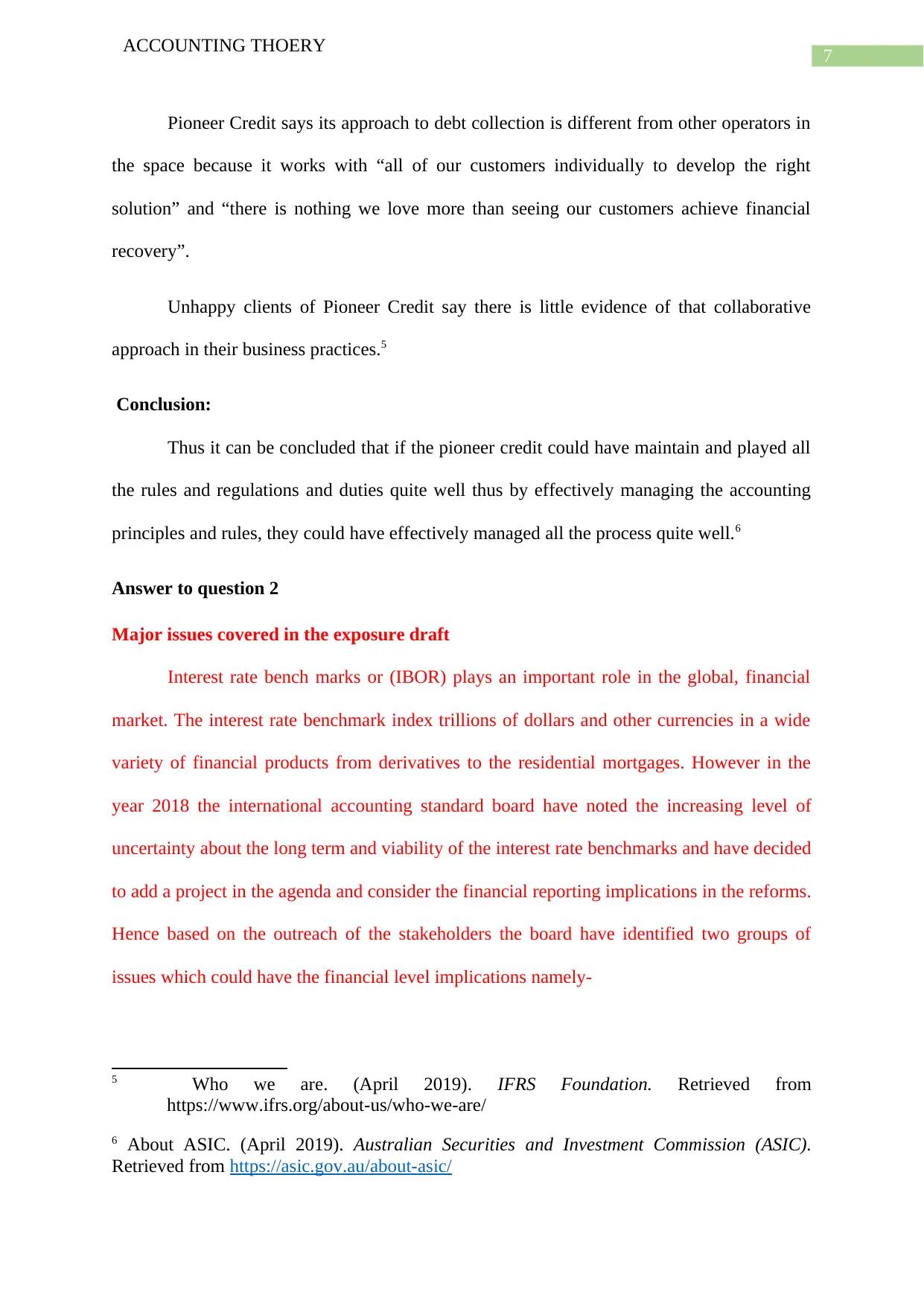
7
ACCOUNTING THOERY
Pioneer Credit says its approach to debt collection is different from other operators in
the space because it works with “all of our customers individually to develop the right
solution” and “there is nothing we love more than seeing our customers achieve financial
recovery”.
Unhappy clients of Pioneer Credit say there is little evidence of that collaborative
approach in their business practices.5
Conclusion:
Thus it can be concluded that if the pioneer credit could have maintain and played all
the rules and regulations and duties quite well thus by effectively managing the accounting
principles and rules, they could have effectively managed all the process quite well.6
Answer to question 2
Major issues covered in the exposure draft
Interest rate bench marks or (IBOR) plays an important role in the global, financial
market. The interest rate benchmark index trillions of dollars and other currencies in a wide
variety of financial products from derivatives to the residential mortgages. However in the
year 2018 the international accounting standard board have noted the increasing level of
uncertainty about the long term and viability of the interest rate benchmarks and have decided
to add a project in the agenda and consider the financial reporting implications in the reforms.
Hence based on the outreach of the stakeholders the board have identified two groups of
issues which could have the financial level implications namely-
5 Who we are. (April 2019). IFRS Foundation. Retrieved from
https://www.ifrs.org/about-us/who-we-are/
6 About ASIC. (April 2019). Australian Securities and Investment Commission (ASIC).
Retrieved from https://asic.gov.au/about-asic/
ACCOUNTING THOERY
Pioneer Credit says its approach to debt collection is different from other operators in
the space because it works with “all of our customers individually to develop the right
solution” and “there is nothing we love more than seeing our customers achieve financial
recovery”.
Unhappy clients of Pioneer Credit say there is little evidence of that collaborative
approach in their business practices.5
Conclusion:
Thus it can be concluded that if the pioneer credit could have maintain and played all
the rules and regulations and duties quite well thus by effectively managing the accounting
principles and rules, they could have effectively managed all the process quite well.6
Answer to question 2
Major issues covered in the exposure draft
Interest rate bench marks or (IBOR) plays an important role in the global, financial
market. The interest rate benchmark index trillions of dollars and other currencies in a wide
variety of financial products from derivatives to the residential mortgages. However in the
year 2018 the international accounting standard board have noted the increasing level of
uncertainty about the long term and viability of the interest rate benchmarks and have decided
to add a project in the agenda and consider the financial reporting implications in the reforms.
Hence based on the outreach of the stakeholders the board have identified two groups of
issues which could have the financial level implications namely-
5 Who we are. (April 2019). IFRS Foundation. Retrieved from
https://www.ifrs.org/about-us/who-we-are/
6 About ASIC. (April 2019). Australian Securities and Investment Commission (ASIC).
Retrieved from https://asic.gov.au/about-asic/
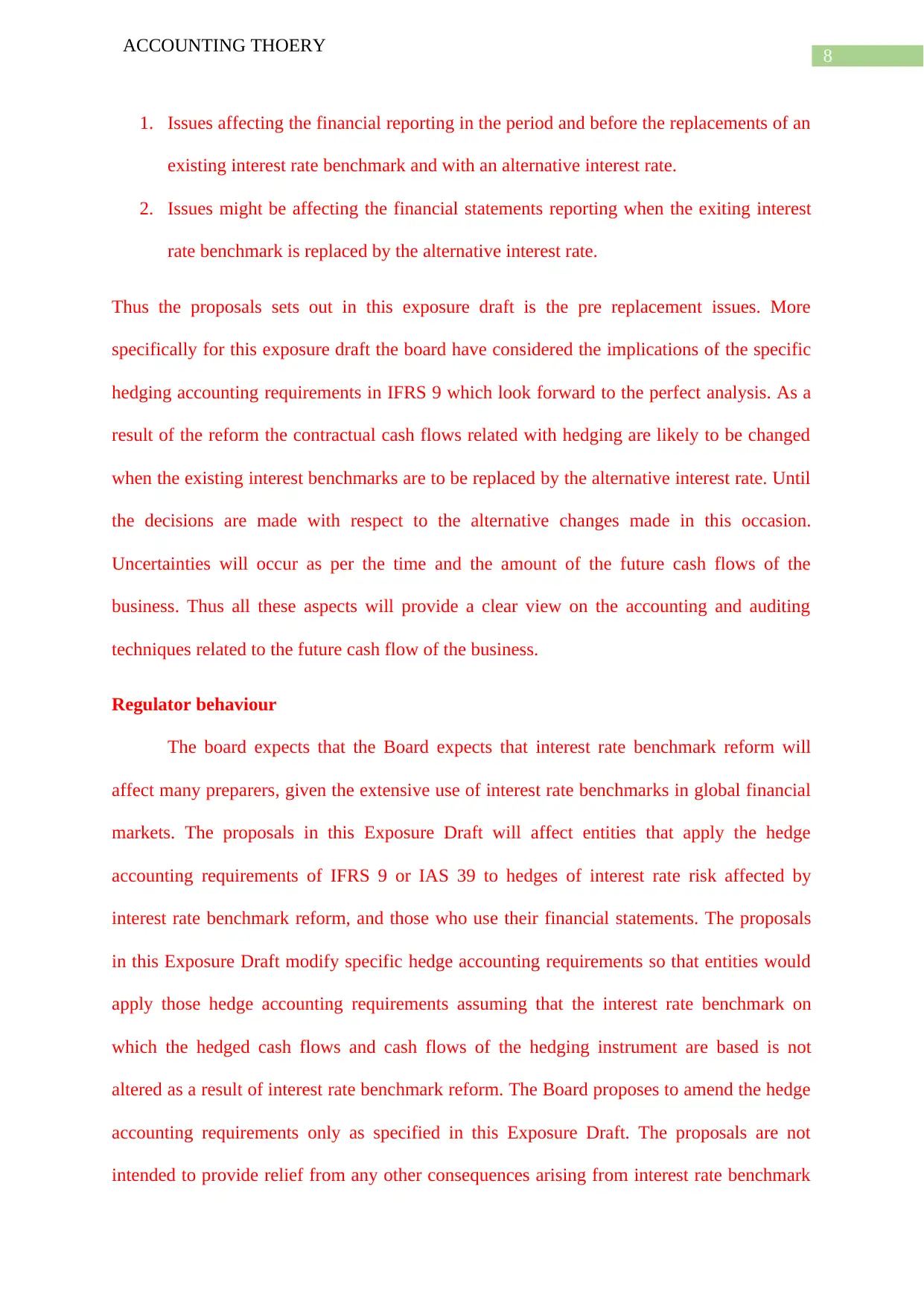
8
ACCOUNTING THOERY
1. Issues affecting the financial reporting in the period and before the replacements of an
existing interest rate benchmark and with an alternative interest rate.
2. Issues might be affecting the financial statements reporting when the exiting interest
rate benchmark is replaced by the alternative interest rate.
Thus the proposals sets out in this exposure draft is the pre replacement issues. More
specifically for this exposure draft the board have considered the implications of the specific
hedging accounting requirements in IFRS 9 which look forward to the perfect analysis. As a
result of the reform the contractual cash flows related with hedging are likely to be changed
when the existing interest benchmarks are to be replaced by the alternative interest rate. Until
the decisions are made with respect to the alternative changes made in this occasion.
Uncertainties will occur as per the time and the amount of the future cash flows of the
business. Thus all these aspects will provide a clear view on the accounting and auditing
techniques related to the future cash flow of the business.
Regulator behaviour
The board expects that the Board expects that interest rate benchmark reform will
affect many preparers, given the extensive use of interest rate benchmarks in global financial
markets. The proposals in this Exposure Draft will affect entities that apply the hedge
accounting requirements of IFRS 9 or IAS 39 to hedges of interest rate risk affected by
interest rate benchmark reform, and those who use their financial statements. The proposals
in this Exposure Draft modify specific hedge accounting requirements so that entities would
apply those hedge accounting requirements assuming that the interest rate benchmark on
which the hedged cash flows and cash flows of the hedging instrument are based is not
altered as a result of interest rate benchmark reform. The Board proposes to amend the hedge
accounting requirements only as specified in this Exposure Draft. The proposals are not
intended to provide relief from any other consequences arising from interest rate benchmark
ACCOUNTING THOERY
1. Issues affecting the financial reporting in the period and before the replacements of an
existing interest rate benchmark and with an alternative interest rate.
2. Issues might be affecting the financial statements reporting when the exiting interest
rate benchmark is replaced by the alternative interest rate.
Thus the proposals sets out in this exposure draft is the pre replacement issues. More
specifically for this exposure draft the board have considered the implications of the specific
hedging accounting requirements in IFRS 9 which look forward to the perfect analysis. As a
result of the reform the contractual cash flows related with hedging are likely to be changed
when the existing interest benchmarks are to be replaced by the alternative interest rate. Until
the decisions are made with respect to the alternative changes made in this occasion.
Uncertainties will occur as per the time and the amount of the future cash flows of the
business. Thus all these aspects will provide a clear view on the accounting and auditing
techniques related to the future cash flow of the business.
Regulator behaviour
The board expects that the Board expects that interest rate benchmark reform will
affect many preparers, given the extensive use of interest rate benchmarks in global financial
markets. The proposals in this Exposure Draft will affect entities that apply the hedge
accounting requirements of IFRS 9 or IAS 39 to hedges of interest rate risk affected by
interest rate benchmark reform, and those who use their financial statements. The proposals
in this Exposure Draft modify specific hedge accounting requirements so that entities would
apply those hedge accounting requirements assuming that the interest rate benchmark on
which the hedged cash flows and cash flows of the hedging instrument are based is not
altered as a result of interest rate benchmark reform. The Board proposes to amend the hedge
accounting requirements only as specified in this Exposure Draft. The proposals are not
intended to provide relief from any other consequences arising from interest rate benchmark
⊘ This is a preview!⊘
Do you want full access?
Subscribe today to unlock all pages.

Trusted by 1+ million students worldwide
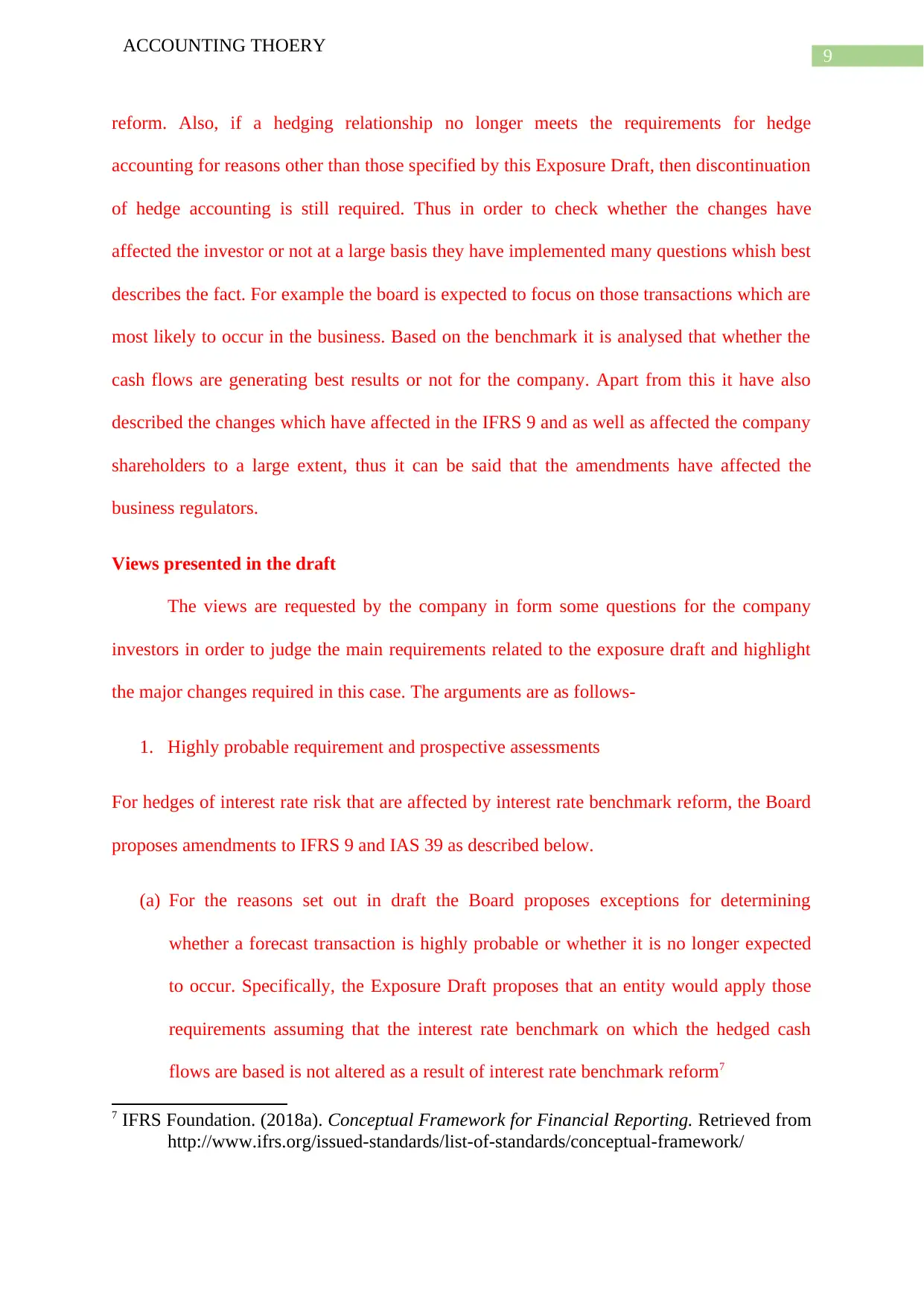
9
ACCOUNTING THOERY
reform. Also, if a hedging relationship no longer meets the requirements for hedge
accounting for reasons other than those specified by this Exposure Draft, then discontinuation
of hedge accounting is still required. Thus in order to check whether the changes have
affected the investor or not at a large basis they have implemented many questions whish best
describes the fact. For example the board is expected to focus on those transactions which are
most likely to occur in the business. Based on the benchmark it is analysed that whether the
cash flows are generating best results or not for the company. Apart from this it have also
described the changes which have affected in the IFRS 9 and as well as affected the company
shareholders to a large extent, thus it can be said that the amendments have affected the
business regulators.
Views presented in the draft
The views are requested by the company in form some questions for the company
investors in order to judge the main requirements related to the exposure draft and highlight
the major changes required in this case. The arguments are as follows-
1. Highly probable requirement and prospective assessments
For hedges of interest rate risk that are affected by interest rate benchmark reform, the Board
proposes amendments to IFRS 9 and IAS 39 as described below.
(a) For the reasons set out in draft the Board proposes exceptions for determining
whether a forecast transaction is highly probable or whether it is no longer expected
to occur. Specifically, the Exposure Draft proposes that an entity would apply those
requirements assuming that the interest rate benchmark on which the hedged cash
flows are based is not altered as a result of interest rate benchmark reform7
7 IFRS Foundation. (2018a). Conceptual Framework for Financial Reporting. Retrieved from
http://www.ifrs.org/issued-standards/list-of-standards/conceptual-framework/
ACCOUNTING THOERY
reform. Also, if a hedging relationship no longer meets the requirements for hedge
accounting for reasons other than those specified by this Exposure Draft, then discontinuation
of hedge accounting is still required. Thus in order to check whether the changes have
affected the investor or not at a large basis they have implemented many questions whish best
describes the fact. For example the board is expected to focus on those transactions which are
most likely to occur in the business. Based on the benchmark it is analysed that whether the
cash flows are generating best results or not for the company. Apart from this it have also
described the changes which have affected in the IFRS 9 and as well as affected the company
shareholders to a large extent, thus it can be said that the amendments have affected the
business regulators.
Views presented in the draft
The views are requested by the company in form some questions for the company
investors in order to judge the main requirements related to the exposure draft and highlight
the major changes required in this case. The arguments are as follows-
1. Highly probable requirement and prospective assessments
For hedges of interest rate risk that are affected by interest rate benchmark reform, the Board
proposes amendments to IFRS 9 and IAS 39 as described below.
(a) For the reasons set out in draft the Board proposes exceptions for determining
whether a forecast transaction is highly probable or whether it is no longer expected
to occur. Specifically, the Exposure Draft proposes that an entity would apply those
requirements assuming that the interest rate benchmark on which the hedged cash
flows are based is not altered as a result of interest rate benchmark reform7
7 IFRS Foundation. (2018a). Conceptual Framework for Financial Reporting. Retrieved from
http://www.ifrs.org/issued-standards/list-of-standards/conceptual-framework/
Paraphrase This Document
Need a fresh take? Get an instant paraphrase of this document with our AI Paraphraser
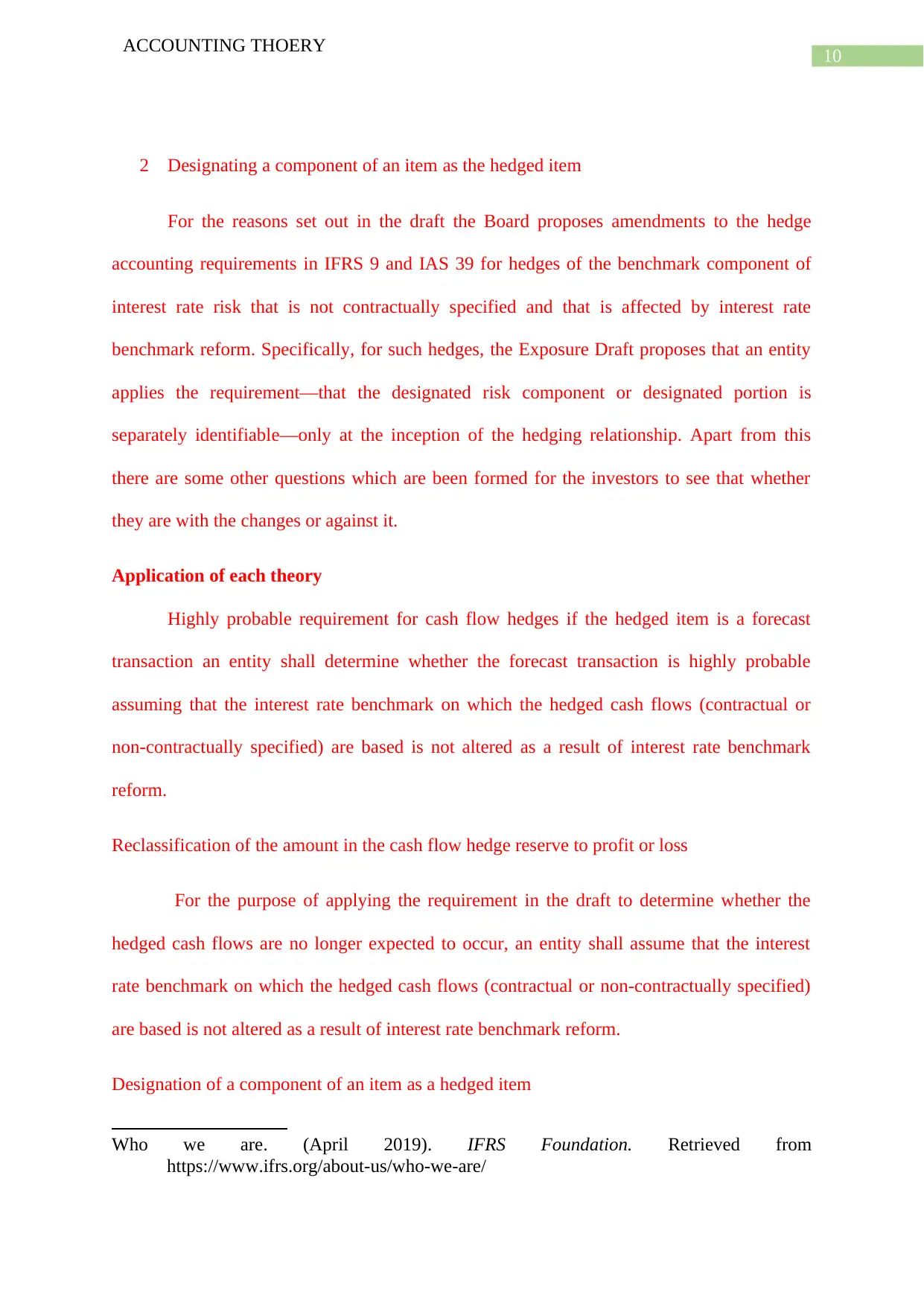
10
ACCOUNTING THOERY
2 Designating a component of an item as the hedged item
For the reasons set out in the draft the Board proposes amendments to the hedge
accounting requirements in IFRS 9 and IAS 39 for hedges of the benchmark component of
interest rate risk that is not contractually specified and that is affected by interest rate
benchmark reform. Specifically, for such hedges, the Exposure Draft proposes that an entity
applies the requirement—that the designated risk component or designated portion is
separately identifiable—only at the inception of the hedging relationship. Apart from this
there are some other questions which are been formed for the investors to see that whether
they are with the changes or against it.
Application of each theory
Highly probable requirement for cash flow hedges if the hedged item is a forecast
transaction an entity shall determine whether the forecast transaction is highly probable
assuming that the interest rate benchmark on which the hedged cash flows (contractual or
non-contractually specified) are based is not altered as a result of interest rate benchmark
reform.
Reclassification of the amount in the cash flow hedge reserve to profit or loss
For the purpose of applying the requirement in the draft to determine whether the
hedged cash flows are no longer expected to occur, an entity shall assume that the interest
rate benchmark on which the hedged cash flows (contractual or non-contractually specified)
are based is not altered as a result of interest rate benchmark reform.
Designation of a component of an item as a hedged item
Who we are. (April 2019). IFRS Foundation. Retrieved from
https://www.ifrs.org/about-us/who-we-are/
ACCOUNTING THOERY
2 Designating a component of an item as the hedged item
For the reasons set out in the draft the Board proposes amendments to the hedge
accounting requirements in IFRS 9 and IAS 39 for hedges of the benchmark component of
interest rate risk that is not contractually specified and that is affected by interest rate
benchmark reform. Specifically, for such hedges, the Exposure Draft proposes that an entity
applies the requirement—that the designated risk component or designated portion is
separately identifiable—only at the inception of the hedging relationship. Apart from this
there are some other questions which are been formed for the investors to see that whether
they are with the changes or against it.
Application of each theory
Highly probable requirement for cash flow hedges if the hedged item is a forecast
transaction an entity shall determine whether the forecast transaction is highly probable
assuming that the interest rate benchmark on which the hedged cash flows (contractual or
non-contractually specified) are based is not altered as a result of interest rate benchmark
reform.
Reclassification of the amount in the cash flow hedge reserve to profit or loss
For the purpose of applying the requirement in the draft to determine whether the
hedged cash flows are no longer expected to occur, an entity shall assume that the interest
rate benchmark on which the hedged cash flows (contractual or non-contractually specified)
are based is not altered as a result of interest rate benchmark reform.
Designation of a component of an item as a hedged item
Who we are. (April 2019). IFRS Foundation. Retrieved from
https://www.ifrs.org/about-us/who-we-are/
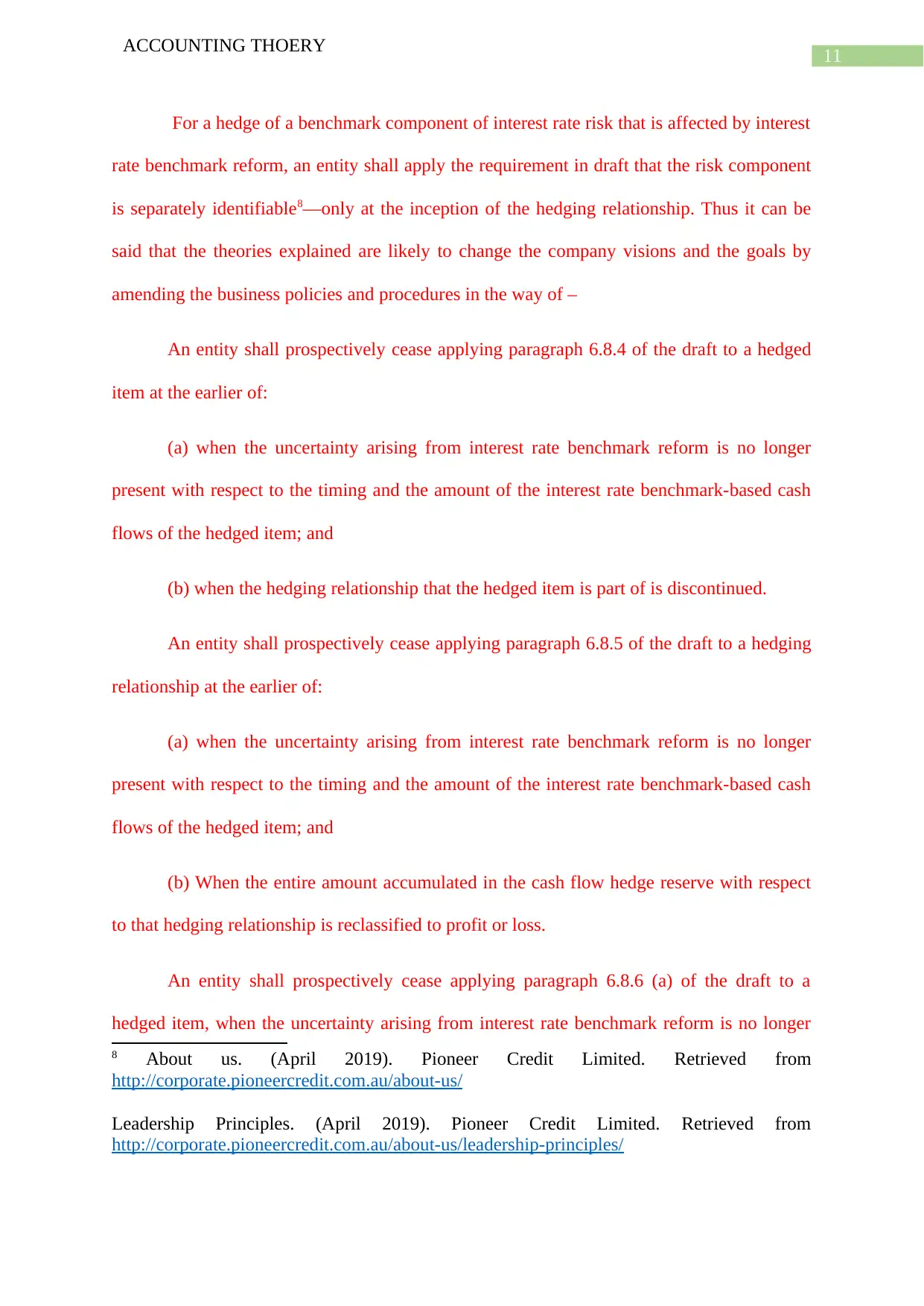
11
ACCOUNTING THOERY
For a hedge of a benchmark component of interest rate risk that is affected by interest
rate benchmark reform, an entity shall apply the requirement in draft that the risk component
is separately identifiable8—only at the inception of the hedging relationship. Thus it can be
said that the theories explained are likely to change the company visions and the goals by
amending the business policies and procedures in the way of –
An entity shall prospectively cease applying paragraph 6.8.4 of the draft to a hedged
item at the earlier of:
(a) when the uncertainty arising from interest rate benchmark reform is no longer
present with respect to the timing and the amount of the interest rate benchmark-based cash
flows of the hedged item; and
(b) when the hedging relationship that the hedged item is part of is discontinued.
An entity shall prospectively cease applying paragraph 6.8.5 of the draft to a hedging
relationship at the earlier of:
(a) when the uncertainty arising from interest rate benchmark reform is no longer
present with respect to the timing and the amount of the interest rate benchmark-based cash
flows of the hedged item; and
(b) When the entire amount accumulated in the cash flow hedge reserve with respect
to that hedging relationship is reclassified to profit or loss.
An entity shall prospectively cease applying paragraph 6.8.6 (a) of the draft to a
hedged item, when the uncertainty arising from interest rate benchmark reform is no longer
8 About us. (April 2019). Pioneer Credit Limited. Retrieved from
http://corporate.pioneercredit.com.au/about-us/
Leadership Principles. (April 2019). Pioneer Credit Limited. Retrieved from
http://corporate.pioneercredit.com.au/about-us/leadership-principles/
ACCOUNTING THOERY
For a hedge of a benchmark component of interest rate risk that is affected by interest
rate benchmark reform, an entity shall apply the requirement in draft that the risk component
is separately identifiable8—only at the inception of the hedging relationship. Thus it can be
said that the theories explained are likely to change the company visions and the goals by
amending the business policies and procedures in the way of –
An entity shall prospectively cease applying paragraph 6.8.4 of the draft to a hedged
item at the earlier of:
(a) when the uncertainty arising from interest rate benchmark reform is no longer
present with respect to the timing and the amount of the interest rate benchmark-based cash
flows of the hedged item; and
(b) when the hedging relationship that the hedged item is part of is discontinued.
An entity shall prospectively cease applying paragraph 6.8.5 of the draft to a hedging
relationship at the earlier of:
(a) when the uncertainty arising from interest rate benchmark reform is no longer
present with respect to the timing and the amount of the interest rate benchmark-based cash
flows of the hedged item; and
(b) When the entire amount accumulated in the cash flow hedge reserve with respect
to that hedging relationship is reclassified to profit or loss.
An entity shall prospectively cease applying paragraph 6.8.6 (a) of the draft to a
hedged item, when the uncertainty arising from interest rate benchmark reform is no longer
8 About us. (April 2019). Pioneer Credit Limited. Retrieved from
http://corporate.pioneercredit.com.au/about-us/
Leadership Principles. (April 2019). Pioneer Credit Limited. Retrieved from
http://corporate.pioneercredit.com.au/about-us/leadership-principles/
⊘ This is a preview!⊘
Do you want full access?
Subscribe today to unlock all pages.

Trusted by 1+ million students worldwide
1 out of 15
Related Documents
Your All-in-One AI-Powered Toolkit for Academic Success.
+13062052269
info@desklib.com
Available 24*7 on WhatsApp / Email
![[object Object]](/_next/static/media/star-bottom.7253800d.svg)
Unlock your academic potential
Copyright © 2020–2025 A2Z Services. All Rights Reserved. Developed and managed by ZUCOL.




